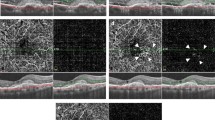Abstract
Purpose
To report the efficacy of intravitreal bevacizumab for either recurrent or persistent serous changes originating from a persistent branching vascular network or secondary choroidal neovascularization after photodynamic therapy for polypoidal choroidal vasculopathy, despite regression of polypoidal lesions.
Methods
Twenty eyes of 20 patients with at least 12 months of regular follow-up were retrospectively reviewed. Intravitreal bevacizumab was administered on an as-needed basis, guided by optical coherence tomography (OCT), after the first injection.
Results
Seventeen (85%) of 20 eyes showed resolution of macular fluid after a mean of 1.9 (range 1–3) consecutive injections; however, 15 (88%) of them had relapsing episodes of fluid collection. The mean number of injections needed was 4.2 (range 1–6) over a period of 12 months. At 12 months, 10 eyes (50%) had no fluid accumulation on OCT, while 10 eyes (50%) had some residual fluid. The mean central foveal thickness improved significantly from 280 ± 37 to 226 ± 62 μm (P = 0.002). Visual acuity was maintained or improved in 16 eyes (80%).
Conclusions
Intravitreal bevacizumab appears to be effective in resolving intraretinal and subretinal fluid originating from these lesions. However, the favorable effect was maintained for only a limited period of time and required repeated injections.



Similar content being viewed by others
References
Spaide RF, Donsoff I, Lam DL, Yannuzzi LA, Jampol LM, Slakter J, et al. Treatment of polypoidal choroidal vasculopathy with photodynamic therapy. Retina. 2002;22:529–35.
Chan WM, Lam DS, Lai TY, Liu DT, Li KK, Yao Y, et al. Photodynamic therapy with verteporfin for symptomatic polypoidal choroidal vasculopathy: one-year results of a prospective case series. Ophthalmology. 2004;111:1576–84.
Silva RM, Figueira J, Cachulo ML, Duarte L, Faria de Abreu JR, Cunha-Vaz JG. Polypoidal choroidal vasculopathy and photodynamic therapy with verteporfin. Graefes Arch Clin Exp Ophthalmol. 2005;243:973–9.
Eandi CM, Ober MD, Freund KB, Slakter JS, Yannuzzi LA. Selective photodynamic therapy for neovascular age-related macular degeneration with polypoidal choroidal neovascularization. Retina. 2007;27:825–31.
Otani A, Sasahara M, Yodoi Y, Aikawa H, Tamura H, Tsujikawa A, et al. Indocyanine green angiography: guided photodynamic therapy for polypoidal choroidal vasculopathy. Am J Ophthalmol. 2007;144:7–14.
Gomi F, Ohji M, Sayanagi K, Sawa M, Sakaguchi H, Oshima Y, et al. One-year outcomes of photodynamic therapy in age-related macular degeneration and polypoidal choroidal vasculopathy in Japanese patients. Ophthalmology. 2008;115:141–6.
Sayanagi K, Gomi F, Sawa M, Ohji M, Tano Y. Long-term follow-up of polypoidal choroidal vasculopathy after photodynamic therapy with verteporfin. Graefes Arch Clin Exp Ophthalmol. 2007;245:1569–71.
Akaza E, Mori R, Yuzawa M. Long-term results of photodynamic therapy of polypoidal choroidal vasculopathy. Retina. 2008;28:717–22.
Lee WK, Lee PY, Lee SK. Photodynamic therapy for polypoidal choroidal vasculopathy: vaso-occlusive effect on the branching vascular network and origin of recurrence. Jpn J Ophthalmol. 2008;52:108–15.
Wakabayashi T, Gomi F, Sawa M, Tsujikawa M, Tano Y. Marked vascular changes of polypoidal choroidal vasculopathy after photodynamic therapy. Br J Ophthalmol. 2008;92:936–40.
Gomi F, Sawa M, Sakaguchi H, Tsujikawa M, Oshima Y, Kamei M, et al. Efficacy of intravitreal bevacizumab for polypoidal choroidal vasculopathy. Br J Ophthalmol. 2008;92:70–3.
Lai TY, Chan WM, Liu DT, Luk FO, Lam DS. Intravitreal bevacizumab (Avastin) with or without photodynamic therapy for the treatment of polypoidal choroidal vasculopathy. Br J Ophthalmol. 2008;92:661–6.
Ojima Y, Hangai M, Sakamoto A, Tsujikawa A, Otani A, Tamura H, et al. Improved visualization of polypoidal choroidal vasculopathy lesions using spectral-domain optical coherence tomography. Retina. 2009;29:52–9.
Costa RA, Navajas EV, Farah ME, Calucci D, Cardillo JA, Scott IU. Polypoidal choroidal vasculopathy: angiographic characterization of the network vascular elements and a new treatment paradigm. Prog Retin Eye Res. 2005;24:560–86.
Goff MJ, Johnson RN, McDonald HR, Ai E, Jumper JM, Fu A. Intravitreal bevacizumab for previously treated choroidal neovascularization from age-related macular degeneration. Retina. 2007;27:432–8.
Arias L, Caminal JM, Casas L, Masuet C, Badia MB, Rubio M, et al. A study comparing two protocols of treatment with intravitreal bevacizumab (Avastin) for neovascular age-related macular degeneration. Br J Ophthalmol. 2008;92:1636–41.
Bashshur ZF, Haddad ZA, Schakal A, Jaafar RF, Saab M, Noureddin BN. Intravitreal bevacizumab for treatment of neovascular age-related macular degeneration: a one-year prospective study. Am J Ophthalmol. 2008;145:249–56.
Sacu S, Michels S, Prager F, Weigert G, Dunavoelgyi R, Geitzenauer W, et al. Randomised clinical trial of intravitreal Avastin vs photodynamic therapy and intravitreal triamcinolone: long-term results. Eye. 2009;23:2223–7.
Costagliola C, Romano M, Corte MD, Perrotta R, Menzione M, Rinaldi M, et al. Intravitreal bevacizumab for treatment-naive patients with subfoveal occult choroidal neovascularization secondary to age-related macular degeneration: a 12-month follow-up study. Retina. 2009;29:1227–34.
Carneiro AM, Falcão MS, Brandão EM, Falcão-Reis FM. Intravitreal bevacizumab for neovascular age-related macular degeneration with or without prior treatment with photodynamic therapy: one-year results. Retina. 2010;30:85–92.
Acknowledgments
The study was approved by the institutional review board of the Catholic Medical Center.
Author information
Authors and Affiliations
Corresponding author
About this article
Cite this article
Kim, K.S., Lee, W.K. Bevacizumab for serous changes originating from a persistent branching vascular network following photodynamic therapy for polypoidal choroidal vasculopathy. Jpn J Ophthalmol 55, 370–377 (2011). https://doi.org/10.1007/s10384-011-0045-z
Received:
Accepted:
Published:
Issue Date:
DOI: https://doi.org/10.1007/s10384-011-0045-z




